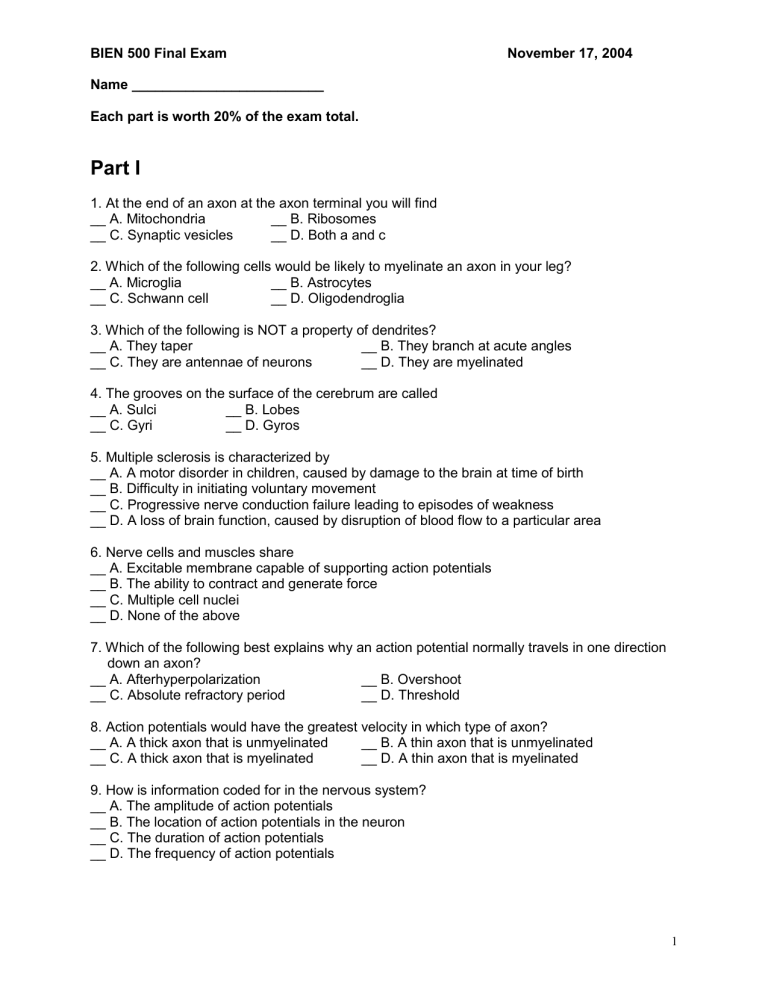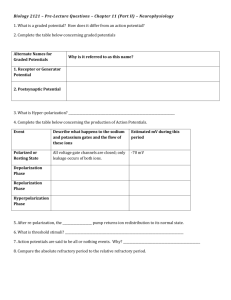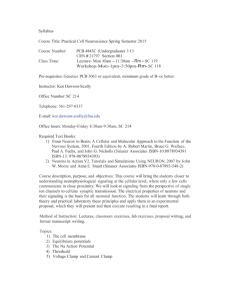BIEN 500 Final Exam

BIEN 500 Final Exam
Name _________________________
Each part is worth 20% of the exam total.
November 17, 2004
Part I
1. At the end of an axon at the axon terminal you will find
__ A. Mitochondria
__ C. Synaptic vesicles
__ B. Ribosomes
__ D. Both a and c
2. Which of the following cells would be likely to myelinate an axon in your leg?
__ A. Microglia
__ C. Schwann cell
__ B. Astrocytes
__ D. Oligodendroglia
3. Which of the following is NOT a property of dendrites?
__ A. They taper
__ C. They are antennae of neurons
__ B. They branch at acute angles
__ D. They are myelinated
4. The grooves on the surface of the cerebrum are called
__ A. Sulci
__ C. Gyri
__ B. Lobes
__ D. Gyros
5. Multiple sclerosis is characterized by
__ A. A motor disorder in children, caused by damage to the brain at time of birth
__ B. Difficulty in initiating voluntary movement
__ C. Progressive nerve conduction failure leading to episodes of weakness
__ D. A loss of brain function, caused by disruption of blood flow to a particular area
6. Nerve cells and muscles share
__ A. Excitable membrane capable of supporting action potentials
__ B. The ability to contract and generate force
__ C. Multiple cell nuclei
__ D. None of the above
7. Which of the following best explains why an action potential normally travels in one direction down an axon?
__ A. Afterhyperpolarization
__ C. Absolute refractory period
__ B. Overshoot
__ D. Threshold
8. Action potentials would have the greatest velocity in which type of axon?
__ A. A thick axon that is unmyelinated __ B. A thin axon that is unmyelinated
__ C. A thick axon that is myelinated __ D. A thin axon that is myelinated
9. How is information coded for in the nervous system?
__ A. The amplitude of action potentials
__ B. The location of action potentials in the neuron
__ C. The duration of action potentials
__ D. The frequency of action potentials
1
BIEN 500 Final Exam
Name _________________________
10. What is a break in the myelin sheath of an axon called?
__ A. A sulcus of Zinn __ B. A node of Ranvier
__ C. A fissure of Probst __ D. A defect
11. Inhibitory postsynaptic potentials (IPSPs)
__ A. Keep a neuron away from threshold
__ B. Occur only at the soma
__ C. Do not spatially summate
__ D. Are always due to the opening of potassium channels
12. Dale's principle states that that a neuron releases
November 17, 2004
__ A. only one neurotransmitter exclusively
__ B. only one amino acid or amine neurotransmitter
__ C. Peptide neurotransmitters
__ D. ACh
13. Which of the following brain structures is most caudal in the human?
__ A. Medulla
__ C. Thalamus
__ B. Pons
__ D. Midbrain
14. The brain and the spinal cord are said to have bilateral symmetry. What does this mean?
__ A. There is constant communication between the two hemispheres
__ B. If split midsagittally, the right and left sides would be structurally identical
__ C. The right side of the brain controls the left side of the body and vice versa
15. A dermatome is the
__ A. Area of skin innervated by one dorsal root ganglion sensory neuron
__ B. Collection of spinal segments that innervate an area of skin
__ C. Area of skin innervated by the dorsal roots of a single spinal segment
16. A Roman gladiator is stabbed in the back during the afternoon's festivities. The LEFT side of the FIRST LUMBAR segment of his spinal cord is cut. What deficit would result from such an injury?
__ A. Loss of proprioceptive information from the right arm
__ B. Loss of tactile information from the left leg
__ C. Loss of temperature information from the right arm
__ D. Loss of nociceptive information from the left leg
17. A cord hemisection of the type described in the preceding question produces a
__________-___________ syndrome.
18. The amount of space that the representation of a body part occupies in a somatotopic map is related to
__ A. How good two-point discrimination is on the skin of that body part
__ B. The innervation density of skin on that body part
__ C. The amount of use of the skin on that body part
__ D. All of the above
2
BIEN 500 Final Exam
Name _________________________
November 17, 2004
19. A red-hot branding iron bearing the words "Neuroscience" is pressed against the palm of your hand. This stimulus activates at least four different pathways within the somatosensory system, each carrying different information. Which of the following would you be aware of first?
__ A. Fast stinging pain __ B. Slow aching pain
__ C. The feel of raised lettering __ D. The fact that it is hot
20. Increasing the intensity of a stimulus to the skin will
__ A. Increase the number and firing rate of active sensory nerves
__ B. Increase the amplitude of the action potentials in the affected sensory nerves
__ C. Increase the conduction velocity of action potentials in the affected nerves
__ D. Increase the innervation density of the affected area of skin
21. When a Pacinian corpuscle is compressed,
__ A. The membrane remains rigid, activating channels in contact with the stimulus
__ B. The membrane is deformed and mechanosensitive ion channels open
__ C. Vibrations in the membrane cause it to hyperpolarize
__ D. The mechanoreceptor fires action potentials for the duration of the stimulus
22. The ipsilateral (e.g., same side) dorsal column carries information concerning
__ A. Tactile sensation on the ipsilateral side
__ B. Limb position of the contralateral side
__ C. Pain sensation on the ipsilateral side
__ D. Temperature sensation of the contralateral side
23. The substantia gelatinosa is located in the
__ A. Medulla
__ C. Dorsal spinal cord
__ B. Thalamus
__ D. Ventral spinal cord
24. The dorsal column
—medial lemniscal pathway and the spinothalamic pathway are significantly different. In which ways are the two pathways similar?
__ A. Their fibers conduct action potentials at the same rate
__ B. Both pathways synapse deep in the dorsal horn of the spinal cord
__ C. Both pathways decussate in the spinal cord
__ D. Both pathways synapse in the VP nucleus of the thalamus
3
BIEN 500 Final Exam
Name _________________________
Part II
November 17, 2004
1. List and briefly describe two common eye conditions limiting the ability of the lens to accommodate.
2. List and briefly describe the function 7 major parts of the eye.
3. List and briefly describe 3 ways we can judge depth perception for objects close to us.
4. Which of the senses has the smallest range of threshold values to maximum values? Why?
5. What is the function of the tensor tympani and stapedius muscles?
6. Functionally, what are the differences between rods and cones in the eyes?
4
BIEN 500 Final Exam
Name _________________________
Fill-In-the-Blank
November 17, 2004
7. The three bones of the middle ear are the ________________, the _____________, and the _____________.
8. The three coiled tubes comprising the cochlea are the _______________, ____________, and the ____________.
9. The refractive power of a convex lens is measured in ____________; it represents the inverse of the ________________.
10. Common causes of blindness include: ______________, ________________, and
___________.
11. The fovea of the eye contains only _______ cells.
5
BIEN 500 Final Exam
Name _________________________
Part III
November 17, 2004
1. The two sens ory receptors found in the muscles are muscle spindles and ………..
2. What is the main function of muscle spindles ?
3. In isometric condition of the extrafusal fibers, the afferent signals from the muscle spindles increase/decreases (circle one) as a result of increased gamma innervation since this would increase/decrease (circle one) the stretch experienced by the muscle spindle by shortening its length.
4. An important function of the stretch reflex is to prevent oscillations and jerkiness of body movements as a result of neural signals transmitted to the muscles in an unsmooth form.
This is called ………….... or …………….. function. (one is sufficient)
5. Two other spinal cord reflexes besides the stretch reflex are ………………..and
…………………..
6. The primary function of the corticospinal tract is to control the …………………
7. An alternative tract to the corticospinal tract that originates in the red nucleus is the
…………………..
8. Somatographical organization means ………………………………………
9. List two of the special control functions of the brain stem: a. . b. .
10. The primary function of the semicircular canals of the vestibular apparatus is to detect
…………….. movements of the head.
11. The nervous system uses the cerebellum to coordinate motor control functions at three levels:………………………. which refers to coordinating mainly the movements of the distal portions of the limbs.
12. The main afferent pathways from the periphery into the cerebellum is called spinocerebellar tract. The dorsal component of this tract caries sensory information of the ……………….,
…………………..,………………., and ………………… from the periphery. (write down only two).
6
BIEN 500 Final Exam November 17, 2004
Name _________________________
13. The ventral component of the spinocerebellar tract caries a copy of the motor signals that arrive at the anterior horns. This feedback is called ………………….. of the anterior horn motor drive.
14. The main functional unit in the cerebellar cortex is the neural circuitry built around a
……………………. and a deep ………….. cell, which is repeated about 30 million times in the cerebellum.
15. Parkinson’s disease has three main symptoms. These are rigidity, tremor, and ……………., which means serious difficulty in initiating movements.
16. Autonomic nervous system has two components: a. . b. .
17. The vagus nerve (Xth cranial nerve) constitutes 75 percent of the ………………… nervous system.
18. An increased sympathetic activity would increase/decrease (circle one) the heart rate and increase/decrease (circle one) the ventricular contractility.
19. There are mainly two types of acetylcholine receptors in the autonomic system: c. . d. .
20. A major difference between the two components of the autonomic system is that one acts locally at each effector organ while the second can have a general effect at the whole body level by causing epinephrine and norepinephrine secretions through the
………………………
21. The firing rates in the autonomic system are in th e order of …………………………. while it is
50 to 500 pulses per second in the skeletal nervous system.
7
BIEN 500 Final Exam
Name _________________________
November 17, 2004
Part IV
1. (24%) Relate the items in column 1 with those in column 2. Each item will be used only once.
Column 1
I. Erythrocytes
II. Neutrophils
III. Extrinsic pathway
Column 2 a. Complement 3b b. Tissue factor c. Kuppfer cells
IV. Opsonin
V. Fibrinolysis
VI. Tissue macrophages d. Anemia e. Inflammation f. Plasminogen
2. Determine the correctness (yes or no) to each of the following statements (2% for each correct answer for a total of 24%):
I. Substrates of thrombin
1. Fibrinogen Yes/No
Yes/No 2. Factor XIII
II. Platelets are activated by
1. Thrombin Yes/No
2. Thromboxane A
2
Yes/No
3. Adenosine triphosphate Yes/No
4. Serotonin Yes/No
3. Factor V
4. Plasminogen
Yes/No
Yes/No
III. Ligands that are recognized by glycoprotein receptor IIb-IIIa
1. Fibrinogen Yes/No 3. Vitronectin
Yes/No 4. Collagens 2. Fibronectin
3. Determine the correct answer to each of the following questions:
I. (2%) Number of platelets that can bind to each fibrinogen molecule.
1. One 2. Two 3. Three 4. Four
Yes/No
Yes/No
II. (3%) Number of oxygen molecule(s) carried by each subunit of hemoglobin A.
1. One 2. Two 3. Three 4. Four
III. (3%) Components of the membrane attack complex
1. C3b 2. C5a 3. C6 4. C9
A. 3 and 4
B. 1, 2 and 3
C. 1, 3 and 4
D. 2, 3 and 4
E. 1,2,3 and 4
8
BIEN 500 Final Exam
Name _________________________
November 17, 2004
IV. (3%) Which of the following condition(s) would increase the rate of erythrocyte production in blood-forming organs?
1.
High altitudes 2. Inhibition of erythropoietin 3. Increased blood flow through peripheral vessels 4. Low hemoglobin
A. 1 and 2
B. 1 and 4
C. 2 and 3
A.
B.
C.
2 only
2 and 4
1, 2 and 3
D. 3 and 4
E. 1,3 and 4
V. (3%) Which of the following has/have anticoagulant activities?
1. Factor V 2. Coumarins 3. Platelet factor 4 4. Thrombomodulin
D.
E.
1, 2 and 4
2, 3 and 4
4. i. (6%) List the common components found in the prothrombinase and tenase complexes.
ii. (12%) List the enzymes and substrates found in the prothrombinase and tenase complexes.
5. (8%) Determine which of the following events belongs to thromboresistance (T) or prothrombotic (P) behavior of endothelial cells. (12%) In one sentence, explain briefly for each answer. i. Degradation of tissue plasminogen activator: ii. Increased production of nitric oxide: iii. Increase production of heparan sulfate: iv. Degradation of adenosine diphosphate:
9
BIEN 500 Final Exam
Name _________________________
November 17, 2004
Part V
Each question should be answe red in ½ to 1 pages. Use the front and back of the attached pages, as necessary.
1) Draw the structure of a nephron, showing regions where permeability to water and ions is high and low, and regions where active transport occurs. Give approximate numbers for urine and tissue osmolarity.
2) Explain what factors affect urine volume and concentration. How do these work to change the kidney’s function in order to maintain homeostasis? Use illustrations and block diagrams, as appropriate, to illustrate your points.
3) What are the primary chemical factors in controlling blood pH? What is the kidney’s role? What other organs play major roles? Discuss maintaining homeostasis in the context of rises or drops in blood pH; what systems are in place to compensate?
10
BIEN 500 Final Exam
Name _________________________
November 17, 2004
11
BIEN 500 Final Exam
Name _________________________
November 17, 2004
12








